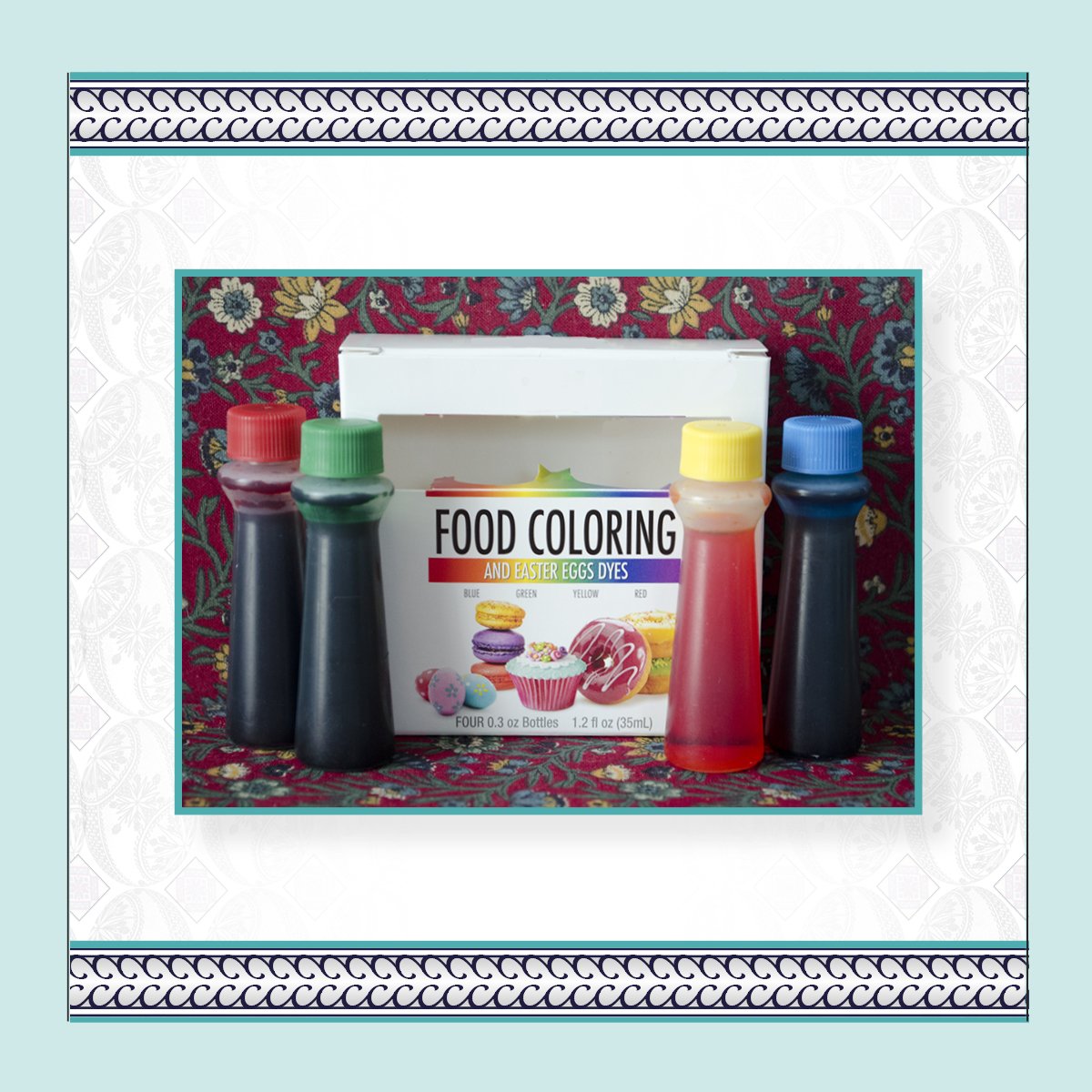Food Coloring
Blog #88
“Here’s another secret I would like to share… I never throw away a dye, no matter what the color quality may be.
As years go by, I add [new aniline] dye packets to the existing dyes and experiment with new colors.”
—Helen Badulak, Pysanky in the 21st Century
Aniline dyes are not the only dyes available to pysanky writers.
Food Coloring, the kind commonly sold in grocery stores for confectionery treats, is also marketed for egg dyeing. It’s a practical option for someone just beginning their pysanka-writing journey or if children are involved. My family continued using these edible dyes to make pysanky even after aniline dyes became available.
The lure of diverse, fast dyeing colors led me to aniline dyes. But here I am many years later exploring Food Coloring once again. Perhaps it’s just nostalgia. Maybe it’s just my need for simplification. Does my dissatisfaction with the aniline dyes on the market today influence this decision? Most likely it is just another creative avenue for me, and maybe you, to pursue.
blending chart for food Coloring
Most color blending recipes suggest using a total of 20 drops of Food Coloring or the equivalent of one teaspoon. My mom mixed one full vial of Food Coloring in 6 ounces of boiling water for the four main colors (red, blue, green, yellow) and experimented on her own creating purple and orange. Her food dyes included one tablespoon of vinegar. It was typical in my family to work on two pysanky at a time — when one was sitting in the dye the other was receiving its beeswax treatment.
The directions, on the Food Coloring box, say to add one teaspoon of vinegar and 20 drops of the desired color to one-half cup of boiling water. Let cool. Dip egg for five minutes or longer. Here’s their dye suggestions for other colors:
Orange: 17 drops of Yellow + 3 drops of Red
Raspberry: 14 drops of Red + 6 drops of Blue
Purple: 15 drops of Blue + 5 drops of Red
Jungle Green: 14 drops of Green + 6 drops of Yellow
Teal: 15 drops of Green + 5 drops of Blue
Rose: 15 drops of Red + 5 drops of Blue
Turquoise: 15 drops of Blue + 5 drops of Green
Exception: Watermelon Red: 25 drops of Red + 2 drops of Blue
In her book, Pysanky in the 21st Century, Helen Badulak writes:
“This is how I mix my dyes: 1 cup boiling water, 1 [aniline] dye packet of color and three tablespoons of vinegar… Every two weeks, religiously, I add three tablespoons of vinegar to freshen my dyes… this is a more concentrated solution than the mixing directions on the dye packets… you must constantly check your egg every few seconds if you mix your dyes like I do. I want the dye to give me immediate results… remove as soon as you achieve your desired color depth.”
The six colors on the above pysanka were achieved using only three dyes — yellow, red and blue.
Here’s how:
One entire vial of Food Coloring was mixed with six ounces of distilled water (boiled), and a tablespoon of vinegar was added to each of the three colors.
YELLOW: After the white lines were waxed-in, the egg was dyed yellow, and the yellow sections were sealed with beeswax. The egg sat in the yellow dye more than 5 minutes.
ORANGE: The egg was dipped in the red dye, once or twice, very quickly, to achieve the orange color.
RED: Once the orange was sealed with beeswax, the egg was placed in the red dye. The red color was achieved rather quickly too; it sat in the dye for three minutes.
PINK: Once the red sections were covered with beeswax, the egg was rinsed in cool water until the rinsing made the egg a desirable pink. Beeswax was then applied to the pink areas, and the egg was rinsed again to remove as much of its unprotected color as possible.
BLUE: The egg dyed blue in less than 5 minutes. The blue sections were then covered with beeswax.
PURPLE: To achieve this final color, the blue egg was put back into the red dye for approximately 6 minutes. When it was removed from the dye, it looked more brown than purple, but it dried with a purple tint.
EACH PYSANKA REFLECTS THE BEAUTY OF ITS CREATOR!
A Prayer by Saint Francis
Lord, make me an instrument of Your peace,
Where there is hatred, let me sow love;
where there is injury, pardon; where there is doubt, faith;
where there is despair, hope; where there is darkness, light;
where there is sadness, joy.
O Divine Spirit,
grant that I may not so much seek to be consoled as to console;
to be understood as to understand; to be loved as to love.
For it is in giving that we receive; it is in pardoning that we are pardoned;
and it is in dying that we are born to eternal life.
Amen
Ukrainian folklore characterizes pysanky as a symbolic, talismanic writing that invokes a higher Universal Power for help, while believing with faithful certainty that It will. The contemporary version of this characterization is a paper-and-pen journaling practice called prayer writing. Both develop a personal relationship with God.
Copyright © 2025 Nancy Kopack.
All rights reserved.

